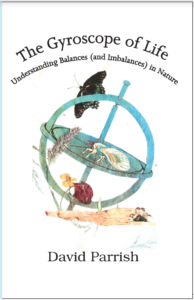FOR IMMEDIATE RELEASE:
BLACKSBURG, Va. — Many of us recall childhood science classes with little enthusiasm, having felt alienated by seemingly esoteric concepts. Appalachian naturalist David Parrish is here to change that. The 50-year practitioner brings biological studies to the curious nonscientist in an accessible and relevant way, inspiring readers to consider the world around us in a new light.
How well are we following Mother Nature’s “house rules?” Are science and religion really in conflict? Are life and death truly binary? These are just a few of the thought-provoking questions that Parrish explores in his new book, “The Gyroscope of Life: Understanding Balances (and Imbalances) in Nature” (Pocahontas Press, 2020).
Parrish tackles concepts relating to biology and agriculture while sharing his personal experiences with religion, battling illness and more, proving not only that science is relevant to daily life, but that it profoundly impacts all of our lives. Whether you’re curious about the sustainability of modern agriculture or the accuracy of “The Big Bang Theory” theme song, David Parrish will move you to think like a scientist in his insightful, unconventional — and often humorous — love song to biology.

“The Gyroscope of Life:
Understanding Balances (and Imbalances) in Nature”
David Parrish | June 2020 | Pocahontas Press | Nonfiction / Science
Paperback | ISBN: 978-0-9967744-7-5 | Price: $17.95
About the Author
 DAVID PARRISH: Parrish is proud to have been born and bred in the hills of Appalachia, and he counts himself fortunate to have worked and played in those same fascinating hills throughout his professional life. After earning his PhD in plant science from Cornell, Parrish joined the faculty of Virginia Tech’s College of Agriculture and Life Sciences, where he was recognized with awards for excellence in teaching and advising. Courses he taught included crop ecology and environmental science. He co-authored a textbook, more than 50 research articles, and several scientific reviews and book chapters. His research interests spanned seed physiology, sustainable cropping systems, and biological sources for renewable energy. In retirement, Parrish and his wife of more than 50 years remain in the mountains of southwestern Virginia on the 30 acres they call Hole in the Woods. He continues to be an avid gardener and outdoorsman, particularly in chasing catch-and-release smallmouth bass on the New River. “The Gyroscope of Life” is his latest work, and will be available for purchase June 2020.
DAVID PARRISH: Parrish is proud to have been born and bred in the hills of Appalachia, and he counts himself fortunate to have worked and played in those same fascinating hills throughout his professional life. After earning his PhD in plant science from Cornell, Parrish joined the faculty of Virginia Tech’s College of Agriculture and Life Sciences, where he was recognized with awards for excellence in teaching and advising. Courses he taught included crop ecology and environmental science. He co-authored a textbook, more than 50 research articles, and several scientific reviews and book chapters. His research interests spanned seed physiology, sustainable cropping systems, and biological sources for renewable energy. In retirement, Parrish and his wife of more than 50 years remain in the mountains of southwestern Virginia on the 30 acres they call Hole in the Woods. He continues to be an avid gardener and outdoorsman, particularly in chasing catch-and-release smallmouth bass on the New River. “The Gyroscope of Life” is his latest work, and will be available for purchase June 2020.
In an interview, David Parrish can discuss:
- The meaning behind the book’s title, “The Gyroscope of Life”
- His ties to fundamentalist religion and his “rebirth” as a scientist
- Why life/death and male/female are not actually binary opposites
- Mother Nature’s “house rules” and how well humans follow them
- How modern agriculture is unsustainable — and what we might need to do to fix it
An Interview with David Parrish
1. The central metaphor of the book is the gyroscope of life. How did you come to think of life in gyroscopic terms?
I was 2 years into this project when the gyroscope metaphor sprang into being during a writing session — just one of those serendipitous things that happen to writers. I had long understood that cells — the basic units of life — are alive only as long as they can maintain the complex assemblages of matter that they are. Anything that disrupts that assemblage puts the life — the stability — of the cell at risk. I was trying to describe that relationship, and the notion of a gyroscope simply appeared. I immediately knew it was solid, and, as I moved on in the project, I realized the same metaphor could be applied at higher, more complex levels, to include ecosystems and even the biosphere.
2. What are some of Mother Nature’s “house rules,” and how well have human beings been following them? Are we in a state of crisis?
Mother Nature has just three house rules — three drop-dead requirements for her children if they are to avoid extinction. (Her “children” are what we think of as species.) I’ll paraphrase her here: 1. Fit your ecosystem; 2. Keep your living complexity together (her equivalent of get and keep your shit together); and 3. Make more of yourselves. By all indications, we 7.7 billion humans are doing great at complying with #2 and #3. It might seem we have found a way around #1, but I suspect we are about to get our suspenders snapped.
3. In “Gyroscope,” you describe the perceived conflict between science and religion, and how you personally were affected by it. How did you resolve this conflict?
I was raised a fundamentalist Christian and was adamantly creationist through my public school years. But, eventually my knowledge of the Bible and my struggle with its conflicting creation accounts (which I knew had to be reconcilable) led me to postulate two separate creations, and that opened my mind to new ways of looking at life. I eventually came to believe that all conflicts between science and religion spring from a failure of each side to understand that it has no dog in the other’s hunt. Science is fact/physics based, while religions are faith/metaphysics based. They are not yin and yang; they are more like matter and antimatter.
4. You also break down binary constructs of life/death and male/female. What are the larger impacts of realizing that these are not binary?
Understanding that alive and dead lie on a spectrum — with some dead stuff acting quite lifelike and some living things acting very dead — is just an intellectual nugget, without any practical applications or implications as far as I can determine. On the other hand, stigma often accrues to those who, for any number of biological reasons, are not totally masculine or totally feminine in their plumbing or in their behavior. Ignorance in this area is a liability. We need to understand sexuality as a biological — not a sociological — phenomenon.
5. This book makes scientific inquiry and biological concepts accessible to nonscientists. Did you write specifically for the nonscientist? Ultimately, what do you hope readers take away from “Gyroscope”?
It was certainly my intent to make biology accessible and relevant for nonscientists, but I think some of the connections drawn in this book might also be of interest to fellow scientists. I hope that scientists and nonscientists alike can have aha moments. I would like for all readers to come away with an appreciation for the importance — and tenuousness — of balance in nature. It has existential implications.

A former award-winning journalist with national exposure, Marissa now oversees the day-to-day operation of the Books Forward author branding and book marketing firm, along with our indie publishing support sister company Books Fluent.
Born and bred in Louisiana, currently living in New Orleans, she has lived and developed a strong base for our company and authors in Chicago and Nashville. Her journalism work has appeared in USA Today, National Geographic and other major publications. She is now interviewed by media on best practices for book marketing.
